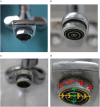Negligible influence of limescale deposits on faucet aerators on measured microorganism loads
- PMID: 40569675
- PMCID: PMC12208179
- DOI: 10.1556/1886.2025.00027
Negligible influence of limescale deposits on faucet aerators on measured microorganism loads
Abstract
Introduction: The study was conducted to assess the effects of limescale deposits on faucet aerators on the qualitative and quantitative detection of microorganisms from swabbing and first jet water samples.
Methods: Limescale deposits on faucet aerators were categorized into three groups: not / slightly calcified, moderately calcified and heavily calcified. Colonization was assessed by isolating microorganisms from standardized swabbing and water samples. Microorganisms isolated from the aerators were compared with clinical isolates from the same year.
Results: Regardless of the degree of calcification on the faucet aerators, similar numbers and types of microorganisms were found. Except for Staphylococcus epidermidis and the rare occurrence of Staphylococcus aureus and Nacaseomyces glabratus on the aerators, there were no matches between the microorganisms isolated from the aerators and the top ten clinical isolates. Microorganisms frequently isolated from aerators, such as Sphingomonas paucimobilis, were extremely rare in clinical samples. No differences in species were observed based on the degree of calcification of the aerators.
Conclusions: The study did not demonstrate a significant effect of the degree of calcification on the colonization of aerators. Although calcification of aerators as a risk factor for increased microbial transmission cannot be entirely dismissed, its importance appears to be secondary.
Keywords: calcification; hygiene; risk; transmission; water quality; waterborne.
Conflict of interest statement
Figures



Similar articles
-
Exercise interventions and patient beliefs for people with hip, knee or hip and knee osteoarthritis: a mixed methods review.Cochrane Database Syst Rev. 2018 Apr 17;4(4):CD010842. doi: 10.1002/14651858.CD010842.pub2. Cochrane Database Syst Rev. 2018. PMID: 29664187 Free PMC article.
-
Home treatment for mental health problems: a systematic review.Health Technol Assess. 2001;5(15):1-139. doi: 10.3310/hta5150. Health Technol Assess. 2001. PMID: 11532236
-
Eliciting adverse effects data from participants in clinical trials.Cochrane Database Syst Rev. 2018 Jan 16;1(1):MR000039. doi: 10.1002/14651858.MR000039.pub2. Cochrane Database Syst Rev. 2018. PMID: 29372930 Free PMC article.
-
The effectiveness and cost-effectiveness of computed tomography screening for coronary artery disease: systematic review.Health Technol Assess. 2006 Oct;10(39):iii-iv, ix-x, 1-41. doi: 10.3310/hta10390. Health Technol Assess. 2006. PMID: 17018228
-
Reminiscence therapy for dementia.Cochrane Database Syst Rev. 2018 Mar 1;3(3):CD001120. doi: 10.1002/14651858.CD001120.pub3. Cochrane Database Syst Rev. 2018. PMID: 29493789 Free PMC article.
References
-
- Anaissie EJ, Penzak SR, Dignani MC. The hospital water supply as a source of nosocomial infections: a plea for action. Arch Intern Med. 2020;162:483–92. - PubMed
-
- Williams MM, Domingo JW, Meckes MC, Kelty CA, Rochon HS. Phylogenetic diversity of drinking water bacteria in a distribution system simulator. J Appl Microbiol. 2004;96:954–64. - PubMed
-
- Ferranti G, Marchesi I, Favale M, Borella P, Bargellini A. Aetiology, source and prevention of waterborne healthcare-associated infections: a review. J Med Microbiol. 2014;63(Pt 10):1247–59. - PubMed
-
- Lowry PW, Blankenship RJ, Gridley W, Troup NJ, Tompkins LS. A cluster of legionella sternal-wound infections due to postoperative topical exposure to contaminated tap water. N Engl J Med. 1991;324:109–13. - PubMed
LinkOut - more resources
Full Text Sources
